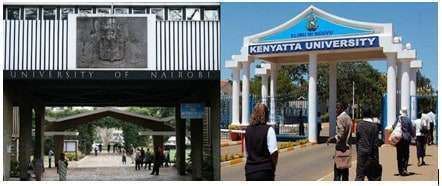November 2nd, 2017
On October 31, 2017 Kenyan President Uhuru Kenyatta was been re-elected for a second term after securing more than 98% of the vote in a highly-contentious rerun election that was boycotted by his main opposition rival.
The recent presidential elections in Kenya have prompted us to report our blog on Kenya where we share with you 25 facts on the country and its education system.
Fast Country Facts:
1. Kenya lies directly on the equator, and is surrounded by Uganda to the south, South Sudan, Ethiopia and Somalia to the north.

2. The size of the country is 582,000 square miles.
3. Some of the oldest known paleontological records of man’s history have been found in Kenya. Kenya’s Great Rift Valley was formed around 20 million years ago, when the crust of the Earth was split.
4. Kenya has a population of 43.5 million with 3.1 million people living in its capital city, Nairobi.

Nairobi, Kenya

Photo credit: Amateur South African Gareth Jones was one of the drivers stuck in the traffic jam on 6/25/13 and decided to get out and photograph the unique scene.
5. Although it does not have an official religion, Christianity is highly prevalent throughout the country.
6. English and Swahili are the country’s official languages.
7. It gained its independence from Great Britain in 1963 and became a parliamentary democracy with a presidential republic with a multi-party system. The government has three branches of power: the Executive, the Legislature and the Judiciary. The Executive is headed by the president, who is democratically elected for a five-year term. The current president is Uhuru Kenyatta.
8. The Kenyan flag is comprised of three colors, black, red and white edges, and green. In the middles of the horizontal flag is a red, white and black Maasai shield. The Massai shield is a traditional symbol in Kenya that is used to symbolize the defense of the country.

Fast Facts on Kenya’s Education System:
9. The Ministry of Education and the Ministry of Higher Education, Science and Technology oversee the country’s entire education system.
10. Old System: 7-4-2-3; established in 1963 after Kenya gained independence. The education system was modelled after the British system and included seven years of primary education, four years of lower secondary education, two years of upper secondary education and three years of university.
11. Current System: 8-4-4-; introduced in 1985 and uses the U.S. education system as a model. It includes eight years of primary education, four years of secondary education and four years of university.
12. School year runs from January to December. The academic year for universities runs from September to June.
13. In 1963 there were only 151 secondary schools, with a total enrolment of 30,120 students. Today there are nearly 3,000 secondary schools with a total enrolment of 620,000 students. Of this total, slightly over 40% are girls
14. Primary education usually starts at six years of age and runs for eight years. At the end of the 8th year, students take exams intended for the award of the Kenya Certificate of Primary Education (KCPE) which covers the following five subjects: Kiswahili, English, mathematics, science and agriculture, and social studies.
15. Secondary school education usually starts at fourteen years of age and, after the introduction of the 8 4-4 system of education which replaced the 7-4-2-3 system, runs for four years. At the end of the 4th year of secondary school, students take exams intended for the Kenya Certificate of Secondary Education (KCSE). The KCSE are national exams administered by the National Examinations Council.

Form four candidates at the Starehe Boys Centre sit for a KCSE paper.
16. Vocational secondary education is available at youth polytechnics for those wishing to pursue a trade and follows after completion of primary education and the award of the Kenya Certificate of Primary Education (KCPE). These programs lead to a variety of diplomas and certificates.
17. Post-secondary technical study programs are delivered by various technical training institutes and institutes of technology. The admission requirement is generally a KCSE with a C average. The study programs offered by technical training institutes and institutes of technology vary in duration. Post-secondary study programs also lead to a variety of certificates and diplomas.
18. Higher education in Kenya includes universities that are either public or private. There are a total of seven public universities; these are independent and funded by the government. Public universities are established through Acts of Parliament. Private universities are established through the process of accreditation by Commission on Higher Education (CHE).

19. At the tertiary level, there are also national polytechnics which offer higher professional education leading to a certificate, diploma and higher national diploma. Two polytechnics have been upgraded to university status and offer degree programs.
20. Admission to higher education at public universities in Kenya is overseen by the Joint Admissions Board (JAB) and has representatives from all public universities as well as the Ministry of Higher Education, Science and Technology and the Commission for Higher Education (CHE). Acceptance to a bachelor’s degree program required the Kenya Certificate of Secondary Education (KCSE) with a C+ average.
21. Admission to certificate and diploma programs at polytechnics requires the KCSE with a D+ or C- average, respectively.
22. University education in Kenya consists of bachelor’s, master’s and doctoral degree programs. Universities also offer Diplomas and Certificates.
23. Bachelor’s degree programs usually consist of major and minor subjects. Depending on the discipline chosen, a bachelor’s program may take 4 to 6 years.
24. Master’s degree program usually take 1 or 2 years. The first year mainly consists of lectures, with the second year spent doing research and end with a final paper. In most cases, admission to a master’s program requires a minimum of an upper second class bachelor’s degree. Those with a bachelor’s qualification below upper second class may be required to complete a postgraduate diploma in the related field before being admitted into the master’s program.
25. A doctorate degree (PhD or DPhil) is awarded after a period of at least 3 years of research conducted during the doctoral program. Admission to a doctorate degree program requires a master’s degree.
Sources:
http://nationfacts.net/kenya-facts/
http://www.kenyaembassy.com/aboutkenyaeducation.html

The Academic Credentials Evaluation Institute, Inc. (ACEI), was founded in 1994 and is based in Los Angeles, CA, USA. ACEI provides a number of services that include evaluations of international academic credentials for U.S. educational equivalence, translation, verification, and professional training programs. ACEI is a Charter and Endorsed Member of the Association of International Credential Evaluators. For more information, visit https://acei-global.org/.


